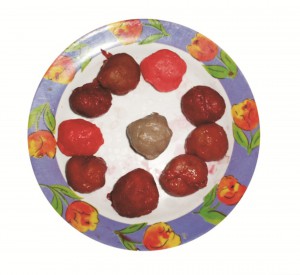THE EFFECT OF SECANG EXTRACT ON MACKEREL FISHBALL
 The effect of secang extract on mackerel fishball in certain concentration and immersion time
The effect of secang extract on mackerel fishball in certain concentration and immersion time
(Picture by: Mohamad Luqman Hakim – Jur. ITP UNS)
One type of the most popular fish ball in society are fish ball made from mackerel, although the consumer acceptance of fish ball are lower than meatballs. This is likely to occur because of the fishy aroma arising from mackerel fish ball as well as the less attractive colors. Thus, it needs to improve the production processes in manufacturing mackerel fish ball to enhance the sensory characteristics. The use of liquid smoke has been shown to provide smoke flavor and reduce the fishy taste of mackerel fish balls, while soaking in secang extract is expected to improve the color, as well as increasing the antioxidant activity of mackerel fish ball.
This study aimed to determine the effect of secang extract concentration (50%, 75%, 100%) and lenght of soaking (5 min, 10 min, 15 min) to the sensory properties, total phenol and antioxidant of smoked mackerel fish ball. Hedonic test conducted to determine the highest level of panelists acceptance to the product which have been soaked in secang extract. Having obtained the fishball that is most preferred by the panelists, antioxidant capacity by DPPH method and total phenols assay by Folin-Ciocalteu method are investigated. Nutrition evaluation of the fish balls is also conducted by comparing to the control. This research used Completely Randomized Design (CRD) factorial with two factors: the concentration of secang extract as well as lenghtof soaking.
The results of this study showed that the most preferred by panelists is the fish balls which is soaked in secang extract in 5 min in concentration 50%. Soaking in secarng extract can increase the antioxidant capacity and total phenols of the smoked mackerel fishball. The process will not influence on the nutritional value of smoked mackerel.
This research was conducted in Department of Food Science and Technology UNS by Nur Her Riyadi, Mohamad Luqman Hakim and Dimas Rahadian AM. You also could read the article in Jurnal Teknologi Hasil Pertanian Vol V No 2 Agustus 2012. For further discussion about this research, please do not hesitate to contact us.
